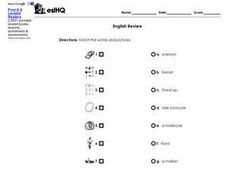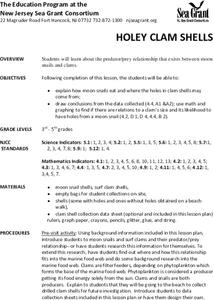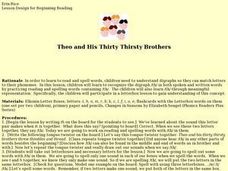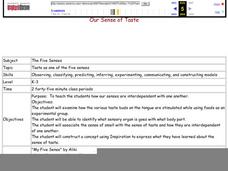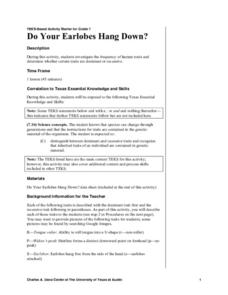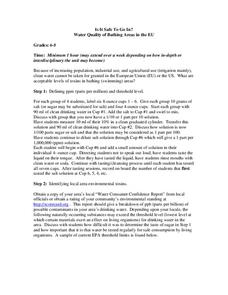Curated OER
Know Your Cousins - Monotremas, Marsupials, and Placentals
Students discover various mammals. In this biology lesson plan, students recognize characteristics of mammals and categorize mammal groupings. Students describe how mammals grow inside the mother's body and resemble their parents at birth.
Curated OER
Ocean World
In this components of the ocean worksheet, students answer 20 questions about various species in the ocean such as plankton, different types of whales, sharks, and herring. Students also answer questions about the volume of water in the...
Curated OER
Mail An Egg Rules
In this mail an egg worksheet, students are given directions to construct a container that will protect an egg using the least possible materials. Students build their structures and mail their egg to another classroom.
Curated OER
Investigating Soil
Students investigate soil contents. In this soil lesson plan, students gather samples of soil and record their findings on a graphic organizer. After analyzing the material in the soil, students illustrate the layers they found.
Curated OER
Amphibians
In this amphibian instructional activity, students read about the frog life cycle to complete the Venn diagram. They also answer 16 fill in the blank questions about frogs.
Curated OER
My Senses Tell Me...
Students explore how to use their sense to draw conclusions. In this human biology lesson, students use their senses to observe various objects in learning centers. The centers include tasting salt, touching sandpaper, hearing bells...
Curated OER
A Medieval Mystery: Can you decode the dark secrets of this cartoon?
Students discover coding in medieval cartoons. In this medieval mystery lesson, students view cartoons from history to see if they can identify the clues or solve the mystery.
Curated OER
I Must/ I Must Not
In this ESL word and picture comprehension learning exercise, learners examine seven pictures and complete a multiple choice question for each. They answer the question that contains the words "must not" or "must."
Curated OER
ESL: Basic Vocabulary Matching
Newcomers to English can practice vocabulary about food, daily actions, and school supplies with this 10-question matching exercise. Simple line drawings represent basic terms for beginners.
Curated OER
ESL: Classmates Survey
Get your beginning English Learners moving with this class survey. They ask each other the 8 questions provided to find out "How many of your classmates..." Good practice for asking questions that start with"Do you..." including "make...
Curated OER
ESL: Practice Using Present Progressive Tense
Small, cartoonish pictures of people expressing emotions and actions (blowing his nose, holding her head and frowning, dancing, smiling) provide the basis for writers to describe the feelings and experiences taking place. Help your ESL...
Curated OER
Make a Lever
Students investigate how to make a lever. In this construction lesson plan, students explore how to construct a lever using dog and tail templates, cardboard, and fasteners. Students construct their simple machine in order to learn about...
Curated OER
Holey Clamshells
Students analyze data to make hypotheses and conclusions regarding the predator/prey relationship between moon snail and surf clams.
Curated OER
Theo and His Thirty Thirsty Brothers
Students recognize the digraph /th/ in both spoken and written words. They read and spell words containing /th/ digraph. They read "Changes in Seasons" by Eizabeth Sengel and make a list of the words containing /th/ digraph.
Curated OER
The Investigation Of The Taste Buds
Students explore the sense of taste. In this biology lesson plan, students investigate the sense of tastes as they experience salty, sour, bitter, and sweet tastes. Students then discover how taste buds do their job.
Curated OER
Thumped
Second graders identify the digraph /th/ in written and spoken language. After a brief discussion of the independent and combined sounds of the phonemes /t/ and /h/ students practice identifying initial and final placement of the new...
Curated OER
CSI Clamshell Investigation
Pupils explore and explain how moon snails eat and where the holes in clamshells come from and then draw conclusion from the data collected. They incorporate math and graphing skills to determine if there is a relationship to a clam's...
Curated OER
Our Sense of Taste
Students explore the relationship between the senses of taste and smell using a blindfold taste test. In partners, they taste different foods with their noses plugged and unplugged. They create a life size outline of the human body to...
Curated OER
Applied Science - Science and Math Pre Lab
Students explore human senses. In this applied Science lesson, students utilize their senses to distinguish various objects. Students explain their descriptions.
Curated OER
Do Your Earlobes Hang down?
Seventh graders listen as the teacher explains the differences between dominant and recessive traits. The data sheet is described and delivered to students. Students collect data about themselves and record it on their sheet. For the...
Curated OER
Silly Sally
First graders identify the grapheme and phoneme for S. They practice writing the letter S and through listening activities, discriminate the phoneme /s/. They associate the phoneme /s/ with its letter representation and identify it as...
Curated OER
A Little Trouble in Amsterdam
Learners read A Little Trouble in Amsterdam and discuss their reading. In this reading comprehension instructional activity, students complete pre-reading activities and post-reading activities for the book A Little Trouble in Amsterdam...
Curated OER
Geometry: Practical Applications of the Distance Formula
Students, working independently and in groups, apply the distance formula to practical situations. After solving various problems, students in pairs design coordinate planes from the school blue print to measure the distance from the...
Curated OER
Is It Safe To Go In? Water Quality of Bathing Areas in the EU
Pupils complete an experiment on water to study water quality. In this water quality lesson, students complete a taste test experiment about chemicals in water. Pupils then study their local water environments and recorded toxins....








